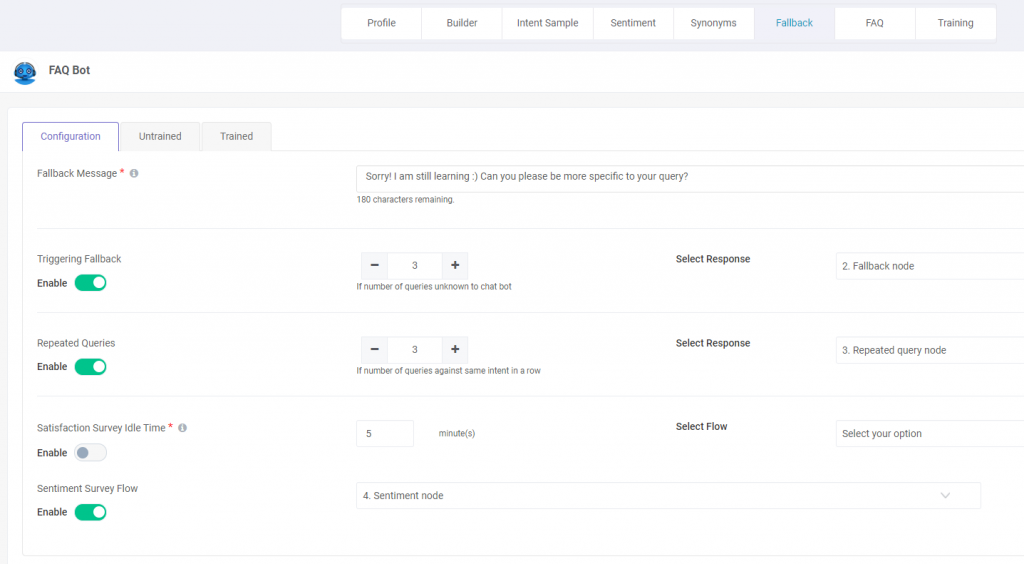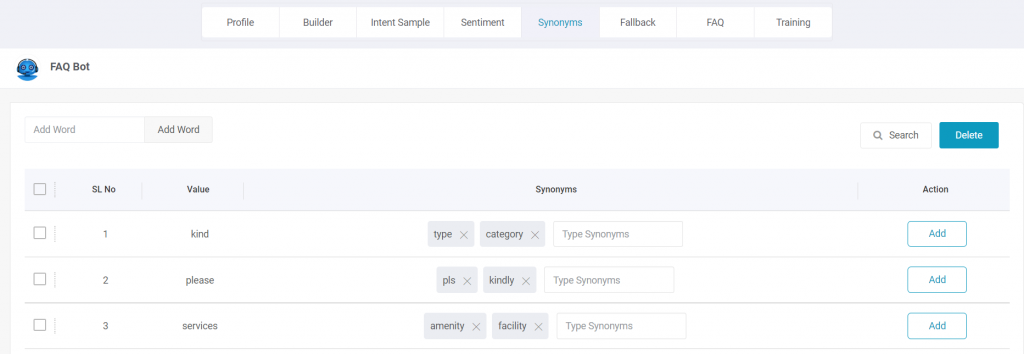Chatbot Fallback Scenarios & Synonyms
Fallback Scenarios
Fallback interaction is a default interaction that pops up when the bot doesn’t recognize the user’s input.
Defining the fallback scenarios is an important part of designing chatbots. When users interact with your bot with a random request they expect a response. If your bot is not capable of fulfilling the user requests, it is not an ideal fit for those scenarios.
The fallback interaction controls the conversation flow by showing a general message when the bot cannot match the user query with any of the interactions. The interaction prompts the user possible options or performing specific actions such as:
- Human handover – If the bot is unable to identify the intent of the user request, without delaying it should be transferred to the human agent.
- Fill up form – The chatbot can offer a form where the user needs to provide few details to be connected again.
- Leave a message – The bot can ask the user to leave a message. The user will be acknowledged with the right solution.
Note: When the fallback scenarios are well defined, there are fewer chances that users might leave confused. Rather it helps to end conversations successfully.
How does fallback work?
1. After setting up the bot profile, you need to define the fallback options for your bot.
Configuration of fallback allows users to set basic settings as follows:
- Fallback message – You have to set up the chatbot’s reply message to the visitor’s query which the bot failed to understand.
- Triggering fallback – Here you can set the frequency for the number of queries unknown to the chatbot for triggering the fallback message.
- Repeated queries – You can set the frequency for the number of queries against the same intent in a row.
- Satisfaction survey idle time – The bot will trigger a proactive message to visitors when they are idle for a certain amount of time. It targets those situations where the visitor is not understanding the bot or simply not sure what to do. Here user can configure to show default/existing node response where the user can set up handover to the human agent.
- Select sentiment survey flow – It defines the bot response in regards to sentiment analysis. For e.g. visitor showing negative emotion (slang/negative emoticon as defined under sentiment module).
2. You can set your chatbot as untrained, it will capture the visitor queries which the bot failed to answer. The bot can be trained with appropriate responses from this section. It will show visitor & date-wise queries.
3. For the trained chatbot, the user will see all the trained data from fallback messages. The user can untrain specific messages if needed. If untrained, the message will move back to the untrained tab under the fallback module
Synonyms
It allows you to configure synonyms from Bot Builder. If the customer uses jargon in his query, the system will understand all the synonyms of it and can use it to match with the corresponding knowledge base.
For example, We have trained the bot on “how to open an account”.
- The customer puts in the query “how to open account”
- In Synonyms Section, the user can configure “acct” as a synonym for “account”. So, the system will match the customer query with the node that is having “how to open an account” as the user says.
- If a particular word is entered as a synonym of a keyword, it cannot be inserted as a synonym for another keyword. So, synonym to the keyword is unique.
- While entering new words, the system will check if it has been already used previously or not.
- If it detects a word that has been used before for another synonymous word, it will notify the user.
- If the visitor uses one of the jargon in his query, the system will understand all the synonyms of it and can use it to match with the corresponding knowledge base.

